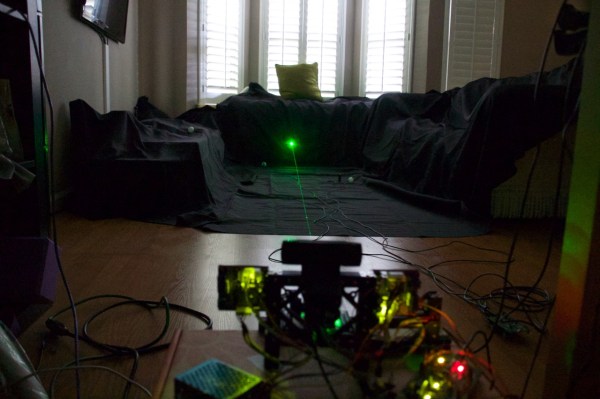What do you get when you cross a mixed-signal oscilloscope, a function generator, a multimeter, a power supply, and some programmable digital I/O in a box? Sounds like the set up to a very geeky joke, but it is actually National Instrument’s VirtualBench product. [Shahriar] has one and wanted to know what was inside, so he did a tear down.
Year: 2015
Building An Automated Laser Turret Targeting System
Last year, [Alvaro] built a laser turret robot for the DEFCONBOTs competition. It worked pretty well, but this year, he decided to step it up a notch. Now instead of moving the entire robot laser array, he’s using galvanometers to move only the laser — he’s essentially built a mini laser projector.
A galvanometer is basically a very sensitive ammeter that moves — it can also be used as a very precise electro-mechanical actuator, for say, moving a tiny mirror. As you can imagine, you can actually build home-made galvanometers — but it’s really not that easy. Instead, [Alvaro] opted to order a few laser show controllers on eBay, and hack his way to a solution — we approve.
Wiring up the galvanometers and making some circuitry for them was the easy part. The tricky part is automating the system.
Continue reading “Building An Automated Laser Turret Targeting System”
Breadboards Go To Pot
Solderless breadboards are great for ICs and discrete components like resistors, capacitors, and transistors (at least the through hole kind). They aren’t so good at holding big components like potentiometers. Sure, you can jam trimmers in maybe. You can also solder leads to a pot, but that’s not pretty and tend to pull out when handled. [PaulStoffregen] got tired of it, so he put together some good looking PC boards that mount a 6mm shaft pot securely to a breadboard.
[Paul] noticed that having delicate or knobless adjustments on a breadboard inhibited people from playing with demo circuits. The new set up invites people to make adjustments. The pictures and video show an early version with six pins, but [Paul] added two more pins on the recent batch to increase the grip of the breadboard.
Build A Sensor Network Around A Weather Station
[Yveaux] had a problem. The transmitter on his outdoor weather station had broken, rendering the inside display useless. He didn’t want to buy a new one, so, like the freelance embedded software designer that he is, he decided to reverse engineer the protocol that the transmitter uses and build his own. He didn’t just replace the transmitter module, though, he decided to create an entire system that integrated the weather system into a sensor network controlled by a Raspberry Pi. That’s a far more substantial project, but it gave him the ability to customize the display and add more features, such as synching the timer in the display with a network clock and storing the data in an online database.
Fortunately for [Yveaux], the transmitter itself was fairly easy to replace. The weather station he had, like most, transmitted on the 868MHz frequency, which is a license-free ISM (Industrial, Scientific and Monitoring) spot on the spectrum. After some poking around, he was able to figure out the protocol and teach the Pi to speak it. He then added a Moteino and an nRF2401+ transmitter to the weather station, so it can send data to the Pi, which then sends it to the display. It is a more complicated setup, but it is also much more flexible. He’s had it running for a couple of years now and has collected more than a million sensor readings.
Hot-Wire CNC Foam Cutter From E Waste
A couple of old DVD ROM drives and a compact photo printer is fairly standard fare at the thrift store, but what do you do with them? Hack them up to make a CNC foam cutter of course!
[Jonah] started with a couple LITE-ON brand DVD RW drives, which use stepper motors instead of plain old DC motors. This is a huge score since steppers make accurate positioning possible. With the internal frames removed, threaded rod and nuts were used to hold the two units parallel to each other forming the Z axis.
The feed mechanism from a Canon compact photo printer was then bolted onto the bottom to form the Y axis. Add a bit of nichrome wire for the cutting element (this can be found in old hair dryers) onto where the laser assembly of the DVD rom once lived, and you have the mechanics done.
Control is handled by an Arduino and some easy-driver modules to interface with the steppers. G-Code is generated by CamBam, which handles various cad files, or has its own geometry editor.
This is a fantastic way to get your feet wet in several ways; Cracking things open to harvest parts, driving steppers with simple micocontrollers, modeling and generating g-code, etc. The one issue we see with this build is a chicken-or-egg problem since you need to have a cube of foam cut down to somewhat strict dimensions before it will fit in this cutter. But we suppose that is really just an iterative design problem.
Two New FPGA Families, Designed In China
The two largest manufacturers of FPGAs are, by far, Altera and Xilinx. They control over 80% of the market share, with Lattice and others picking up the tail end. The impact of this can be seen in EE labs and alibaba; nearly every FPGA dev board, every instructional, and every bit of coursework is based on Altera or Xilinx chips.
There’s a new contender from the east. Gowin Semiconductor has released two lines of FPGAs (Google translate) in just under two years. That’s incredibly fast for a company that appears to be gearing up to take on the Altera and Xilinx monolith.
The FPGA line released last week, the GW1N family, is comprised of two devices with 1,152 and 8,640 LUTs. These FPGAs are built on a 55nm process, and are meant to compete with the low end of Altera’s and Xilinx’ offerings. This adds to Gowin’s portfolio introduced last May with the GW2A (Google translate) family, featuring devices ranging from 18,000 to 55,000 LUTs and DSP blocks. Packages will range from easily solderable QFN32 and LQFP100, to BGA packages with more pins than an eighteenth century seamstress at the royal ball.
For comparison, Xilinx’ Spartan-6 LX family begins with devices featuring 3,840 LUTs and 216kb of block RAM, with larger devices featuring 147,443 LUTs and up to 268kb of block RAM. Altera’s Cyclone IV E devices are similarly equipped, with devices ranging from 6,272 to 114,480 LUTs. Between the two device families introduced by Gowin recently, nearly the entire market of low-end FPGAs is covered, and they’re improving on the current offerings: the GW1N chips feature random access on-chip Flash memory. Neither the low-end devices from Altera nor devices from Lattice provide random-access Flash.
The toolchain for Gowin’s new FPGAs is based nearly entirely on Synopsys’ Synplify Pro, with dedicated tools from Gowin for transforming HDL into a bitstream for the chip. This deal was inked last year. As for when these devices will make it to market, Gowin is hoping to send out kits to well-qualified devs soon, and the devices may soon show up in the warehouses of distributors.
Gowin’s FPGAs, in contrast to the vast, vast majority of FPGAs, are designed and fabbed in China. This gives Gowin a unique home-field advantage in the land where everything is made. With LVDS, DSP, and other peripherals these FPGAs can handle, Gowin’s offerings open up a wide variety of options to developers and product engineers a few miles away from the Gowin plant.
The GW1N and GW2A families of FPGAs are fairly small when it comes to the world of FPGAs. This limitation is by capability though, and not number of units shipped. It’s nearly tautological that the largest market for FPGAs would be consumer goods, and Gowin is focusing on what will sell well before digging in to higher end designs. We will be seeing these chips show up in devices shortly, and with that comes a new platform to tinker around with.
If you’re looking to make your mark on the world of open source hardware and software, you could do worse than to start digging into the synthesis and bitstream of these Gowin chips. Just months ago, Lattice’s iCE40 bitstream was reverse engineered, and already there are a few boards capitalizing on a fully open source toolchain for programmable logic. With more capable FPGAs coming out of China that could be stuffed into every imaginable product, it’s a golden opportunity for hardware hackers and developers alike.
[Thanks for the tip Antti]
Hollywood Finally Gets Hacking Right With Mr. Robot
Author’s note: I’m keeping spoilers out of this article, but they will surely show up in the comments.
A few weeks ago I started hearing about a new show on the USA network, Mr. Robot. The synopsis for the show was “Mr. Robot is a psychological thriller that follows a young programmer who works as a cyber-security engineer by day and a vigilante hacker by night.” Yeah, that sounds like another Hollywood crapfest. Cue crazy GUIs and virtual reality flybys representing hacking scenes. After watching the pilot though, I realized I couldn’t have been more wrong. I was hooked for the entire 10 week first season.
 Let’s start with the hacking, which is the whole reason this article is here on Hackaday. Show creator [Sam Esmail] isn’t a hacker himself, but he is tech savvy enough to see how poorly hacking has been portrayed on TV and in the movies. He knew he could do it better. The solution was good consultants, in the form of [Michael Bazzell] and others. The team helped shape the show into a rather realistic portrayal of hacking techniques. Elliot Alderson (Rami Malek), the main character, is the “vigilante” hacker described in the synopsis. Within the first 10 minutes of the pilot, he is turning a child pornographer in to the police. How does he catch the creeper? Tor exit node exploits, of course.
Let’s start with the hacking, which is the whole reason this article is here on Hackaday. Show creator [Sam Esmail] isn’t a hacker himself, but he is tech savvy enough to see how poorly hacking has been portrayed on TV and in the movies. He knew he could do it better. The solution was good consultants, in the form of [Michael Bazzell] and others. The team helped shape the show into a rather realistic portrayal of hacking techniques. Elliot Alderson (Rami Malek), the main character, is the “vigilante” hacker described in the synopsis. Within the first 10 minutes of the pilot, he is turning a child pornographer in to the police. How does he catch the creeper? Tor exit node exploits, of course.
The onion routing protocol is not as anonymous as you think it is. Whoever’s in control of the exit nodes is also in control of the traffic, which makes me the one in control.
This is an accurate description of some of the exploits which have been demonstrated on the tor network. There aren’t any VR hacking scenes to be found either. In fact, several characters watch and make fun of the “flu shot” scene in Hackers. In this show, the command line isn’t hidden, it’s celebrated. We see every command the characters type, from netstat to CAN bus dumps. In one scene, Elliot even fires up a windows virtual machine so he can run DeepSound on his Kali Linux box.
The hacking isn’t all software either. Everyone’s favorite Linux single board computer is featured prominently in the first season. We can’t knock a show where a character looks at another and says “Ok, we all know what a Raspberry Pi is, what’s your point?”
Continue reading “Hollywood Finally Gets Hacking Right With Mr. Robot”

















